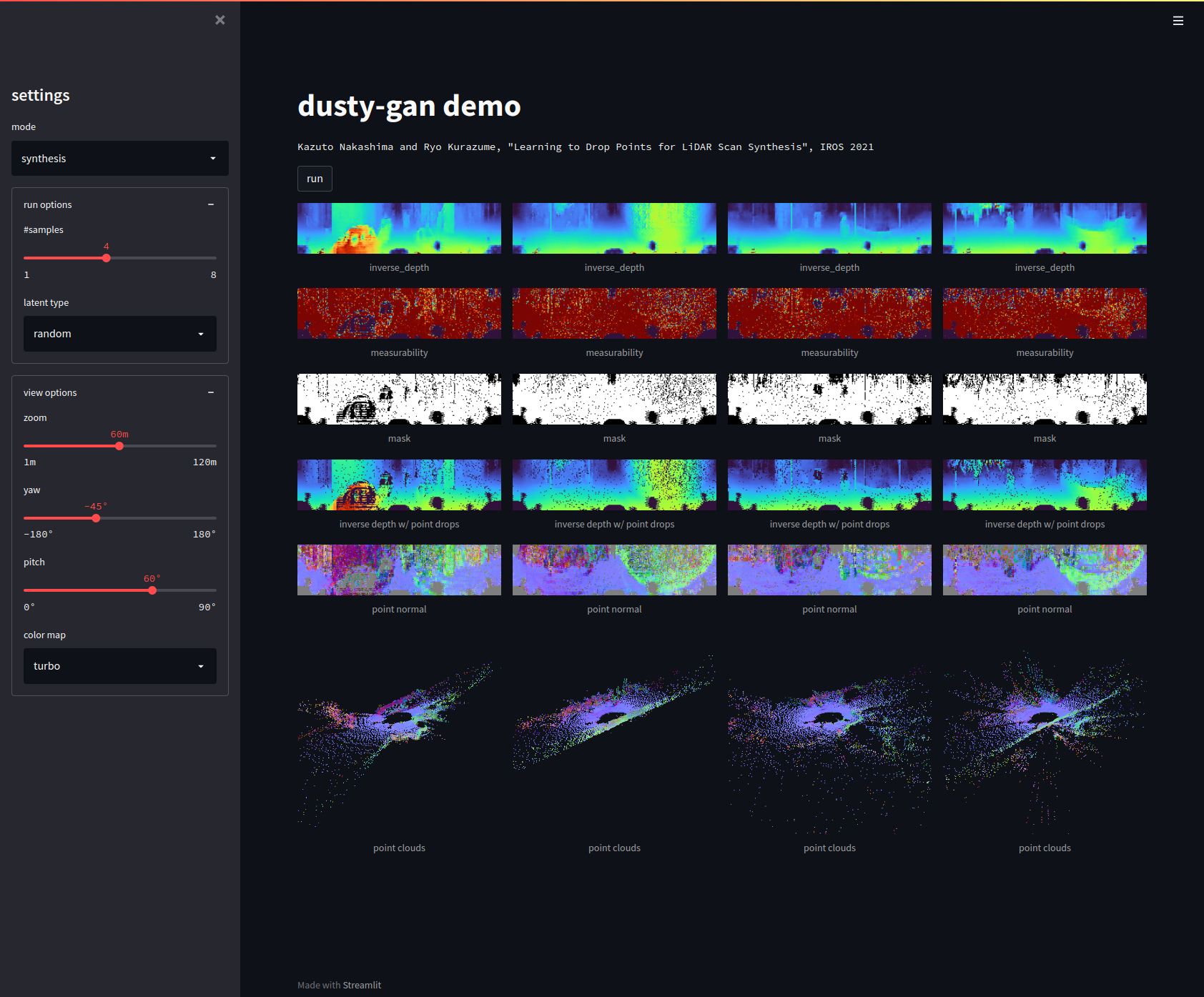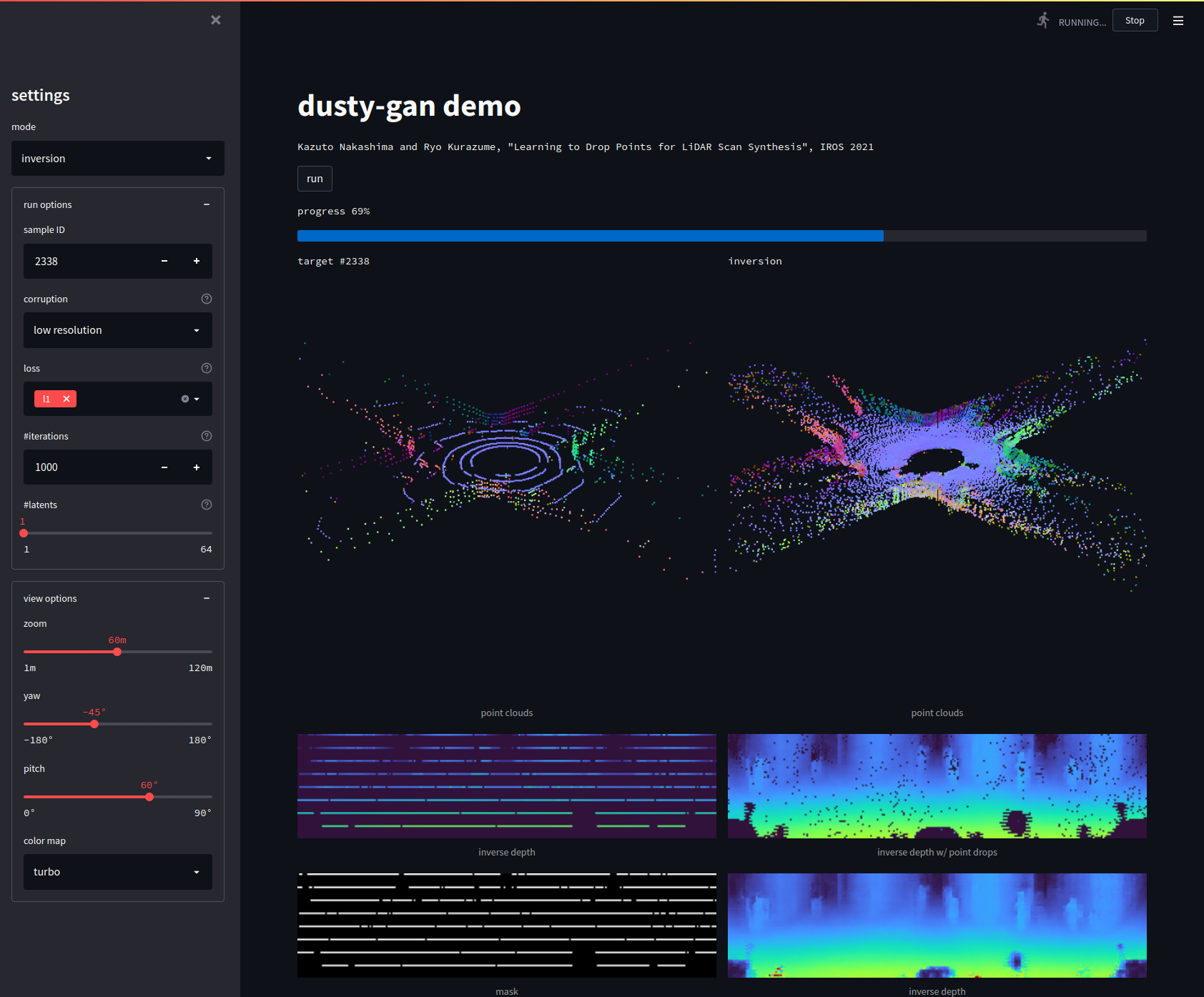This repository provides the official PyTorch implementation of the following paper:
Learning to Drop Points for LiDAR Scan Synthesis
Kazuto Nakashima and Ryo Kurazume
In IROS 2021
[Project] [Paper]
Overview: We propose a noise-aware GAN for generative modeling of 3D LiDAR data on a projected 2D representation (aka spherical projection). Although the 2D representation has been adopted in many LiDAR processing tasks, generative modeling is non-trivial due to the discrete dropout noises caused by LiDAR’s lossy measurement. Our GAN can effectively learn the LiDAR data by representing such discrete data distribution as a composite of two modalities: an underlying complete depth and the corresponding reflective uncertainty.
Generation: The learned depth map (left), the measurability map for simulating the point-drops (center), and the final depth map (right).
Reconstruction: The trained generator can be used as a scene prior to restore LiDAR data.
To setup with anaconda:
$ conda env create -f environment.yaml
$ conda activate dusty-ganPlease follow the instruction for KITTI Odometry. This step produces the azimuth/elevation coordinates (angles.pt) aligned
with the image grid, which are required for all the following steps.
 |
 |
|---|
| Dataset | LiDAR | Method | Weight | Configuration |
|---|---|---|---|---|
| KITTI Odometry | Velodyne HDL-64E | Baseline | Download | Download |
| DUSty-I | Download | Download | ||
| DUSty-II | Download | Download |
Please use train.py with dataset=, solver=, and model= options.
The default configurations are defined under configs/ and can be overridden via a console (reference).
$ python train.py dataset=kitti_odometry solver=nsgan_eqlr model=dcgan_eqlr # baseline
$ python train.py dataset=kitti_odometry solver=nsgan_eqlr model=dusty1_dcgan_eqlr # DUSty-I (ours)
$ python train.py dataset=kitti_odometry solver=nsgan_eqlr model=dusty2_dcgan_eqlr # DUSty-II (ours)Each run creates a unique directory with saved weights and log file.
outputs/logs
└── dataset=<DATASET>
└── model=<MODEL>
└── solver=<SOLVER>
└── <DATE>
└── <TIME>
├── .hydra
│ └── config.yaml # all configuration parameters
├── models
│ ├── ...
│ └── checkpoint_0025000000.pth # trained weights
└── runs
└── <TENSORBOARD FILES> # logged losses, scores, and imagesTo monitor losses, scores, and images, run the following command to launch TensorBoard.
$ tensorboard --logdir outputs/logsTo evaluate synthesis performance, run:
$ python evaluate_synthesis.py --model-path $MODEL_PATH --config-path $CONFIG_PATHMODEL_PATH and CONFIG_PATH are .pth file and the corresponding .hydra/config.yaml file, respectively.
A relative tolerance to detect the point-drop can be changed via --tol option (default 0).
To evaluate reconstruction performance, run:
$ python evaluate_reconstruction.py --model-path $MODEL_PATH --config-path $CONFIG_PATHTo optimize the relative tolerance for the baseline in our paper, run:
$ python tune_tolerance.py --model-path $MODEL_PATH --config-path $CONFIG_PATHWe used 0.008 for KITTI.
$ streamlit run demo.py $MODEL_PATH $CONFIG_PATH| Synthesis | Reconstruction |
|---|---|
 |
 |
If you find this code helpful, please cite our paper:
@inproceedings{nakashima2021learning,
title = {Learning to Drop Points for LiDAR Scan Synthesis},
author = {Nakashima, Kazuto and Kurazume, Ryo},
booktitle = {IEEE/RSJ International Conference on Intelligent Robots and Systems (IROS)},
pages = {222--229},
year = 2021
}